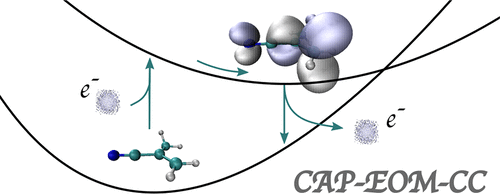当前位置:
X-MOL 学术
›
J. Chem. Theory Comput.
›
论文详情
Our official English website, www.x-mol.net, welcomes your
feedback! (Note: you will need to create a separate account there.)
Structure Optimization of Temporary Anions
Journal of Chemical Theory and Computation ( IF 5.7 ) Pub Date : 2018-06-08 00:00:00 , DOI: 10.1021/acs.jctc.8b00128 Zsuzsanna Benda 1 , Kerstin Rickmeyer 1 , Thomas-C. Jagau 1
Journal of Chemical Theory and Computation ( IF 5.7 ) Pub Date : 2018-06-08 00:00:00 , DOI: 10.1021/acs.jctc.8b00128 Zsuzsanna Benda 1 , Kerstin Rickmeyer 1 , Thomas-C. Jagau 1
Affiliation

|
We determine equilibrium structures, adiabatic electron affinities, and resonance widths of various temporary anions to benchmark the complex absorbing potential equation-of-motion coupled-cluster (CAP-EOM-CC) method. The second-order approximation to CAP-EOM-CC with singles and doubles (SD) excitations is found to yield slightly lower resonance positions and widths than full CAP-EOM-CCSD. The basis set dependence of adiabatic resonance positions and widths is similar to that of the vertical quantities. We demonstrate the usefulness of structure optimizations of temporary anions by two examples. For the anions of acrylonitrile and methacrylonitrile, we observe good agreement for the adiabatic electron affinities and structural changes between our theoretical results and two-dimensional electron-energy loss spectra. For the unsaturated hydrocarbons ethylene, 1,3-butadiene, and cis- and trans-1,3,5-hexatriene, the agreement between theory and electron transmission spectroscopy is good for the lower-lying π* resonances, while our results for the 3π* resonance of trans-hexatriene suggest a shortcoming of the method or reinterpretation of the corresponding electron transmission spectrum. The experimentally determined difference between the electron affinities of the 2π* resonances of the cis isomer and the trans isomer of hexatriene are reproduced well by CAP-EOM-EA-CCSD and CAP-EOM-EA-CCSD(2).
中文翻译:

临时阴离子的结构优化
我们确定平衡结构,绝热电子亲和力和各种临时阴离子的共振宽度,以基准复杂吸收势的运动耦合簇方程(CAP-EOM-CC)方法。发现单次和两次激发(SD)对CAP-EOM-CC的二阶近似比完全CAP-EOM-CCSD产生的共振位置和宽度稍低。绝热共振位置和宽度的基集依赖性类似于垂直量的依赖性。我们通过两个例子证明了临时阴离子结构优化的有用性。对于丙烯腈和甲基丙烯腈的阴离子,我们的绝热电子亲和力和结构变化在我们的理论结果和二维电子-能量损失谱之间观察到了很好的一致性。顺式和反式-1,3,5-己三烯,理论与电子透射光谱之间的一致性对于较低的π*共振很好,而我们对反式-己三烯的3π*共振的结果表明该方法的缺点或重新解释相应的电子传输光谱。CAP-EOM-EA-CCSD和CAP-EOM-EA-CCSD(2)很好地再现了实验确定的顺式异构体的2π*共振和己三烯的反式异构体的电子亲和力之间的差异(2)。
更新日期:2018-06-08
中文翻译:

临时阴离子的结构优化
我们确定平衡结构,绝热电子亲和力和各种临时阴离子的共振宽度,以基准复杂吸收势的运动耦合簇方程(CAP-EOM-CC)方法。发现单次和两次激发(SD)对CAP-EOM-CC的二阶近似比完全CAP-EOM-CCSD产生的共振位置和宽度稍低。绝热共振位置和宽度的基集依赖性类似于垂直量的依赖性。我们通过两个例子证明了临时阴离子结构优化的有用性。对于丙烯腈和甲基丙烯腈的阴离子,我们的绝热电子亲和力和结构变化在我们的理论结果和二维电子-能量损失谱之间观察到了很好的一致性。顺式和反式-1,3,5-己三烯,理论与电子透射光谱之间的一致性对于较低的π*共振很好,而我们对反式-己三烯的3π*共振的结果表明该方法的缺点或重新解释相应的电子传输光谱。CAP-EOM-EA-CCSD和CAP-EOM-EA-CCSD(2)很好地再现了实验确定的顺式异构体的2π*共振和己三烯的反式异构体的电子亲和力之间的差异(2)。











































 京公网安备 11010802027423号
京公网安备 11010802027423号